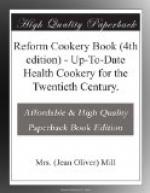One of the chief difficulties experienced by those trying to compass a complete scheme of hygienic dietary, is to get a pure, wholesome, easily digested, and, at the same time, palatable bread. We have long since exploded the idea that whiteness is a test of superiority, for we know that this is attained by excluding the most wholesome and nutritious part of the wheat and by the use of chemicals. Even when we use brown bread, we are by no means sure of having a wholemeal loaf, for it is as often as not merely the ordinary flour with some bran mixed in. And bran is only one part—by no means the most important—of that in which the meal is lacking. We want to get as much as possible of the real “germ,” the essential part of the grain, but I am informed by experts, that the process of drying and preparing this germ meal is so much more troublesome, and, in consequence, expensive, that the easier and cheaper method is that generally adopted. But, if we want a really good thing we must be willing to pay for it, and by creating a demand for the superior article make it worth while to manufacture it, and it were poor economy to save on the bread bill at the expense of health. It is well to know exactly what constitutes a really wholesome bread, for bakers and purveyors everywhere are ready to meet their customers’ wishes. But if people are ignorant or unreasonable enough to demand a light-coloured, puffy loaf, when a pure whole-wheat loaf is rather dark and solid looking, they must be prepared to find that they are served with what pleases their taste, and to take the risks. Some may like to try baking their bread at home, and it may interest them to know that it is possible to make very good wheaten bread without any raising ingredients whatever, simply with wheatmeal and water, aerating it by beating air into it. This is best managed by the home baker in the form of
Wheatmeal Gems.
There are sets of thick iron gem pans to be had, which are very good for this purpose, but one can manage quite well with oven-plates made of sheet-iron or black steel.
Into a large basin put 2 cupfuls of the coldest water procurable. Aerate by pouring from one vessel to another several times, or by whipping up with a spoon or spatula. Take 4 cupfuls whole meal, and pass several times through a sieve. Sprinkle the meal into the water a little at a time, whipping vigorously all the while till about three-fourths are worked in, and continue whisking from 20 to 30 minutes till the mixture is full of air bubbles. Sprinkle in the rest of the wheatmeal and mix thoroughly. Meanwhile, see that the oven is very hot, as a strong steady heat is necessary. Make the gem pans or oven-plates also very hot and grease lightly. Half fill the pans and put at once in oven, so that the moist air may be as quickly as possible converted into steam, and thus puff up the bread. If oven-plates are used, put dessertspoonfuls some distance apart




